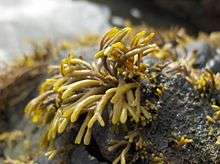Wrack (seaweed)



Wrack is part of the common names of several species of seaweed in the family Fucaceae. It may also refer more generally to any seaweeds or seagrasses that wash up on beaches and may accumulate in the wrack zone.[1]
It consists largely of species of Fucus — brown seaweeds with flat branched ribbon-like fronds, characterized in F. serratus by a saw-toothed margin and in F. vesiculosus, another common species, by bearing air-bladders. Another component of sea wrack may be seagrasses such as Zostera marina a marine flowering plant with bright green long narrow grass-like leaves.[2] Posidonia australis, which occurs sub-tidally on the southern coasts of Australia, sheds its older ribbon-like leaf blades in winter, resulting in thick accumulations along more sheltered shorelines.
- "Bladder wrack", Fucus vesiculosus
- "Channelled wrack", Pelvetia canaliculata
- "Knotted wrack", Ascophyllum nodosum
- "Spiral wrack" or "flat wrack", Fucus spiralis
- "Toothed wrack" or "serrated wrack", Fucus serratus
Historically wrack was used for making manure, and for making "kelp",[2] a form of potash.[3]
References
- ↑ J. H. Frank & Kee-Jeong Ahn (2011). "Coastal Staphylinidae (Coleoptera): a worldwide checklist, biogeography and natural history". ZooKeys. 107: 1–98. doi:10.3897/zookeys.107.1651. PMID 22792029.
- 1 2 Chisholm 1911, p. 566.
- ↑ Rev. Dr. Walker (1788). "An Essay on Kelp", in Prize Essays and Transactions of The Highland Society of Scotland. Edinburgh. Retrieved March 10, 2015.
 This article incorporates text from a publication now in the public domain: Chisholm, Hugh, ed. (1911). "Seawrack". Encyclopædia Britannica. 24 (11th ed.). Cambridge University Press. p. 566.
This article incorporates text from a publication now in the public domain: Chisholm, Hugh, ed. (1911). "Seawrack". Encyclopædia Britannica. 24 (11th ed.). Cambridge University Press. p. 566.